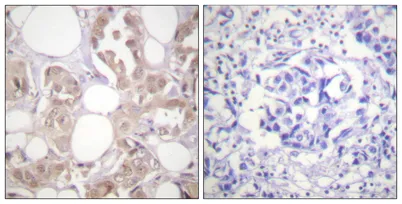Cdk7 (phospho Thr170) rabbit pAb
CAT:
855-ES4442-02
Size:
100 μL
Price:
Ask
- Availability: 24/48H Stock Items & 2 to 6 Weeks non Stock Items.
- Dry Ice Shipment: No




Cdk7 (phospho Thr170) rabbit pAb
- Description: Cyclin dependent kinase 7 (CDK7) Homo sapiens The protein encoded by this gene is a member of the cyclin-dependent protein kinase (CDK) family. CDK family members are highly similar to the gene products of Saccharomyces cerevisiae cdc28, and Schizosaccharomyces pombe cdc2, and are known to be important regulators of cell cycle progression. This protein forms a trimeric complex with cyclin H and MAT1, which functions as a Cdk-activating kinase (CAK). It is an essential component of the transcription factor TFIIH, that is involved in transcription initiation and DNA repair. This protein is thought to serve as a direct link between the regulation of transcription and the cell cycle. [provided by RefSeq, Jul 2008],
- Synonyms: CDK7; CAK; CAK1; CDKN7; MO15; STK1; Cyclin-dependent kinase 7; 39 kDa protein kinase; p39 Mo15; CDK-activating kinase 1; Cell division protein kinase 7; Serine/threonine-protein kinase 1; TFIIH basal transcription factor complex kinase subu
- Gene ID: 1022
- UniProt: P50613
- Cellular Locus: Nucleus. Cytoplasm. Cytoplasm, perinuclear region. Colocalizes with PRKCI in the cytoplasm and nucleus (PubMed:15695176). Translocates from the nucleus to cytoplasm and perinuclear region in response to DNA-bound peptides (PubMed:19071173)..
- Host: Rabbit
- Species Reactivity: Human, Mouse
- Immunogen: The antiserum was produced against synthesized peptide derived from human CDK7 around the phosphorylation site of Thr170. AA range:136-185
- Clonality: Polyclonal
- Validated Applications: WB, IHC, IF, ELISA
- Stability: 1 year
- Concentration: 1 mg/mL
- Dilution: Western Blot: 1/500 - 1/2000. Immunohistochemistry: 1/100 - 1/300. ELISA: 1/20000. Not yet tested in other applications.
- Molecular Weight: 40kD
- Storage Conditions: PBS with 0.02% sodium azide and 50% glycerol pH 7.4. Store at -20°C. Avoid repeated freeze-thaw cycles.
